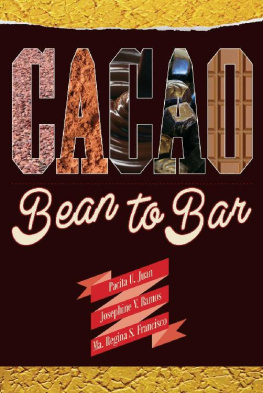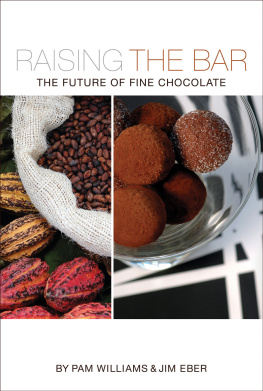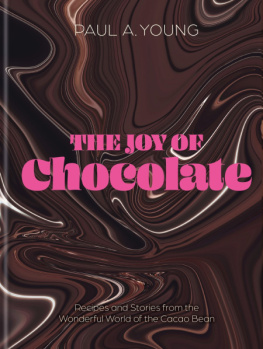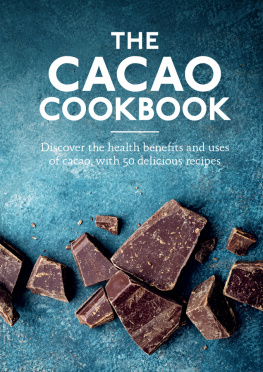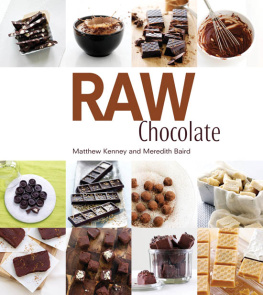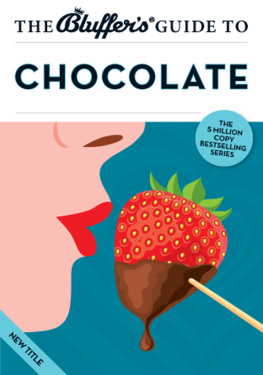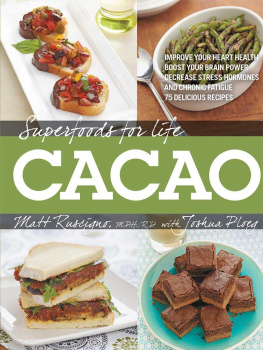Cacao
Bean to Bar
a cacao growers manual
Pacita U. Juan
Josephine V. Ramos
Ma. Regina S. Francisco
Cacao: Bean to Bar
by Pacita U. Juan, Josephine V. Ramos and Ma. Regina S. Francisco
Copyright to this digital edition 2013
Pacita U. Juan, Josephine V. Ramos, Ma. Regina S. Francisco
and Anvil Publishing, Inc.
All rights reserved. No part of this book may be reproduced in any form
or by any means without the written permission of the copyright owners.
Published and exclusively distributed by
ANVIL PUBLISHING, INC.
7th Floor Quad Alpha Centrum Building
125 Pioneer Street, Mandaluyong City
1550 Philippines
Sales and Marketing:
Fax: (+632) 7471622
www.anvilpublishing.com
Book design by R. Jordan P. Santos (cover) and Joshene Bersales (interior)
Cover photos courtesy of the following:
Cacao beans and chocolate by Ma. Regina S. Francisco
Liquid chocolate and chocolate bar by Young-Ice Graphics
(http://youngicegfx.weebly.com)
Cocoa powder photo by R. Jordan P. Santos
Folio and inside photos from the collections of Pacita U. Juan, Josephine V. Ramos,
Ma. Regina S. Francisco, R. Jordan P. Santos and Young-Ice Graphics
ISBN 9789712729157 (e-book)
Version 1.0.1
Contents
M ore than just savoring a hot, frothy tsoklate, or having a bite of mouthwatering, luscious chocolate bars, my passion for cacao is buried deep in sentiment, nurtured by Filipino food traditions and rooted in my familys ties to the land.
I was raised in a simple rural household, our backyard dotted with many crops which included cacao trees. My grandfather used to harvest ripe cacao fruits, gather us kids to take one bean at a time and eat the mucilage, but with a warning not to bite the seeds inside as he would select the best ones for planting. The rest of the beans were dried and stored in rattan baskets lined with woven coconut fronds. They were kept for two reasonsone is to have something to sell when we needed money for small school expenses, and the other, to have tsoklate during Christmas, visits, family get-togethers, and on rainy days when all the kids had to stay inside the house.
It was a simple memory from my daily family life whichas I discovered during work-related visits and talks with rural households in several places in the Philippineswas similar to the past of thousands of other Filipino families.
This kindled a burning desire for me to share my experiences, knowledge, and learnings about cacao. For one, I believe that we should sustain one of the many beautiful Filipino traditions of family togetherness. There is also a huge livelihood and business opportunity in the different stages of the cacao value chain, aside from its health benefits and nutrition value.
The Philippines has yet to define and stage itself as one of the significant cacao producers in the world, but strengths, opportunities and enabling conditions abound, waiting to be taken and transformed into added income for farmers, healthy and thriving cacao-producing communities, and larger groups of responsible nature stewards that should perpetuate the benefits of this food for the gods.
This book shares a wealth of information about cacao through the agesits history of use, ways of consumption, processing and the processed products, growing cacao, and even some recipes. This is our attempt to help in the development of small and big businesses in cacaofrom beans to bars.
Josephine V. Ramos
To Ms. KARINA BOLASCO and Ms. GWENN GALVEZ for believing in our concept of a cacao growers book;
To Ms. JOYCE BERSALES for her patience in sending our files back and forth and keeping us aligned to our timetable;
To Ms. CRIS ABIVA for accepting the role of editor and being tolerant of our minor challenges in gathering data;
To Ms. MERLYN SANOPAO for testing all the recipes and trying all the tablea samples we gathered from many places around the country;
To Mr. ROMY AND LINDA FRIAS for their support;
To chocolate advocates for allowing us to tell their stories.
The origins of cacao
I t was probably the monkeys and squirrels who first discovered that the cacao plant was edible, its sweet, filling pulp concealed within a thick pod. The animals ate the pulp, then spat out the seeds. Ancient man followed their example, picking the ripe fruit from the trees as they walked past and eating only the delicious pulp. This was probably what Mother Nature had in mindto disseminate the seeds and guarantee the cacaos evolution.
In historical accounts of the Mesoamerican culture, an ancient tribe called the Moyaka were the first to use cacao as a beverage by gathering the pulp coating of the bean. The Olmecs (3001200 B.C.E.) were probably the first to domesticate the plant, which they called kakaw or cacao. The Olmec civilization was based on agriculture, and archaeologists findings indicate that cacao beans were a treasured part of their diet and culture from as early as 600 B.C. They were the also the first Mesoamericans to develop large religious ceremonial centers and the first to use a solar calendar. The Olmec civilization flourished before the Maya.
The Mayan Civilization (300900 C.E.) was built on ideas inherited from the Olmec. The Mayans were considered the most culturally advanced among the Mesoamerican civilizations with their majestic pyramid-temples and palaces and complex written language that filled thousands of books. They were also the first true chocolate aficionados, treasuring cacao as a restorative, mood-enhancing cure-all. They would consume cacao as a spicy, chili-laced drink for its invigorating and health-promoting qualities. It became an integral part of their society, used in ceremonies, given as gifts, and incorporated into their mythologies.
The Mayan religion believed that cacao had divine origins. In their sacred book, Popul Vuh, the story of creation mentions not an apple tree, but a cacao tree.
By 900 A.D., a new group of peoples emerged to challenge the supremacy of the Mayansthe Toltecs. They captured the Yucatan Peninsula and gained control of cacao-rich lands and cacao trading rights. The Toltecs also saw cacao as a divine gift, believing the god Quetzalcoatl had given the bean to men and taught them how to cultivate it. Legend has it that Quetzalcoatl was banished by the other gods for offering the divine drink to mortals, but that he swore to return.
Centuries later in the age of the Aztecs, a legend surfaced that cacao seeds had been brought from paradise and that eating the fruit brought wisdom and power. The Aztecs consumed cacao as a liquid like the Mayans did. It came in the form of a beverage that they called xocoatl.
In the Aztec aristocratic society in the fourteenth to sixteenth centuries, chocolate was reserved mainly for the nobility, priests, and the elite. The earliest known chocolate lover was the Aztec ruler Montezuma who took no other beverage save the xocoatl, a potion of chocolate flavored with vanilla and spices, frothed and sweetened with honey. The fact that Montezuma consumed goblets of this drink before entering his harem spawned the belief that it was an aphrodisiac.
A delicacy for kings, to everyones favorite treat, from a sacred and revered health food to a modern scientific wonder. The history of chocolate is rich, varied, and immensely fascinating.

